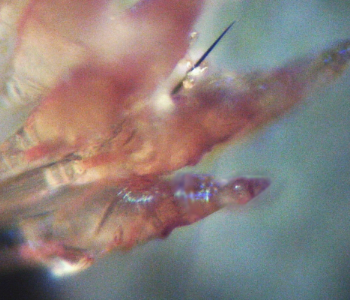Diptera.info :: Miscellaneous :: General queries
Who is here? 1 guest(s)
|
Stigmatomyces ceratophorus
|
|
| johnes81 |
Posted on 14-07-2017 23:21
|
|
Member Location: Berlin, Germany Posts: 1980 Joined: 15.10.16 |
Hello everyone, I am hoping for some useful information about Stigmatomyces ceratophorus. is Fannia canicularis always the host of Stigmatomyces ceratophorus? I have a photo of a Fannia canicularis with a fungus which seems to be Stigmatomyces. if Fannia canicularis is the main host, then the fungus should be ceratophorus. I found a book with some keys: Notes on the Laboulbeniales (Ascomycota) parasitic on Diptera from Portugal and other countries W. Rossi, S. Santamaria and R. Andrade https://www.researchgate.net/publication/261364768_Notes_on_the_Laboulbeniales_Ascomycota_parasitic_on_Diptera_from_Portugal_and_other_countries the keys for Stigmatomyces ceratophorus: Axis of the free appendage branched ... ceratophorus exactly where is the free appendage? anyone know of a resource for thallus/fungi morphology/anatomy? I've attached a microscopic photo of the thalli. Maybe someone can confirm Stigmatomyces ceratophorus. Thank You. ps: I didn't know where to post this query. I hope that General queries is ok. johnes81 attached the following image:  [159.04Kb] Edited by johnes81 on 14-07-2017 23:22 |
|
|
|
| Jan Maca |
Posted on 19-07-2017 09:50
|
|
Member Location: Posts: 1280 Joined: 25.03.10 |
W. Rossi (valter.rossi@univaq.it) confirmed the determination. He is working on a monographic paper on Laboulbeniales parasitic on Diptera and thus he is interested in receiving the fly with fungi. This is also true for any fungus on any fly from any country. Address: Prof. W. Rossi, Universita de l´Áquila, Dip. di medicína clinica, scienze de la vita e dell´ambiente, I-67100 Coppito - L´Aquila, Italia |
|
|
|
| Danny Haelewaters |
Posted on 19-07-2017 18:29
|
|
Member Location: Bruges, Belgium Posts: 14 Joined: 19.08.12 |
Hello John, I attach a figure from Hughes et al. 2004, in which structures are labeled. The species in this figure is Stigmatomyces australis (scale bar = 50 µm). fo: Foot, the single point of attachment to the host I, II, III: Cells I, II, and III of the receptacle VI: Cell VI, basal cell of the perithecium per: Perithecium an: Antheridia, which are formed on the free appendage. The entire structure above cell III is the appendage. I hope this helps with regard to the morphology. Danny Danny Haelewaters attached the following image:  [70.01Kb] Edited by Danny Haelewaters on 19-07-2017 18:55 Danny Haelewaters https://dannyhaelewaters.com https://twitter.com/dhaelewa |
| johnes81 |
Posted on 21-07-2017 19:16
|
|
Member Location: Berlin, Germany Posts: 1980 Joined: 15.10.16 |
Jan Maca wrote: W. Rossi (valter.rossi@univaq.it) confirmed the determination. He is working on a monographic paper on Laboulbeniales parasitic on Diptera and thus he is interested in receiving the fly with fungi. This is also true for any fungus on any fly from any country. Address: Prof. W. Rossi, Universita de l´Áquila, Dip. di medicína clinica, scienze de la vita e dell´ambiente, I-67100 Coppito - L´Aquila, Italia FANtastic! I am very Thankful for the confirmation. I am pleasantly surprised about Sir Rossi being the individual to confirm the identification. I never expected this to happen. I cannot Thank Sir Rossi enough. I am sorry to inform you that I have dissected the fly for identification. I usually have to identify animals alone, so I never plan for help. Honestly, I didn't think that anyone would reply to this thread. I am always willing to help an expert with research material. Sir Rossi can make more use of a specimen. I just identify species. I try to study fungi because I find fungi to be very fascinating. I will continue to learn/study but I will definitely send diptera with fungi to Sir Rossi. I see diptera with fungi every few months, so I will start collecting for Sir Rossi. I just need to know how to store the specimen for Sir Rossi. If dna study is required, then I will use 95% ethanol. Otherwise, I will need instructions from you. Thank You x googolplex! |
|
|
|
| johnes81 |
Posted on 21-07-2017 19:28
|
|
Member Location: Berlin, Germany Posts: 1980 Joined: 15.10.16 |
Danny Haelewaters wrote: Hello John, I attach a figure from Hughes et al. 2004, in which structures are labeled. The species in this figure is Stigmatomyces australis (scale bar = 50 µm). fo: Foot, the single point of attachment to the host I, II, III: Cells I, II, and III of the receptacle VI: Cell VI, basal cell of the perithecium per: Perithecium an: Antheridia, which are formed on the free appendage. The entire structure above cell III is the appendage. I hope this helps with regard to the morphology. Danny Thank You very much Sir Haelewaters. I never know to address a superior. I always worry that I will offend someone here. I hope that informal language is okay with you. I am sorry for not replying sooner. I have been very busy with research/identification. Plus I have a Wife and a Son. I am short on time this week. I am so very happy to learn the terminology. I want to learn more about fungi, so this is the beginning for me. You are a great person to make time to help me. Thank You. I understand that you study Hesperomyces. I always find Harmonia axyridis with Hesperomyces, which got me interested in knowing more about fungi. Anyway, if you ever need a specimen for study, then please let me know. I will be happy to collect for you. I hope that you have a Wonderful Day. I'm off to work again. I've removed the epigynum of a Cheiracanthium and Philodromus, so I now begins the identification work. Although, I feel confident that I have mildei and cespitum. I still must follow protocol. Goodnight all... |
|
|
|
| Jump to Forum: |













